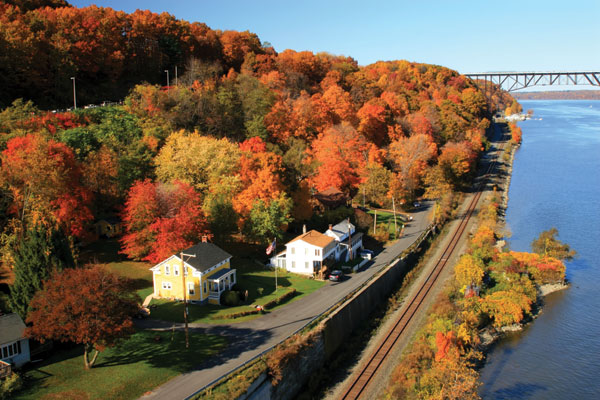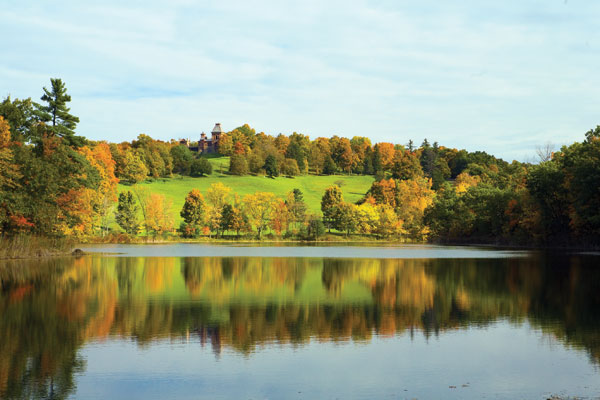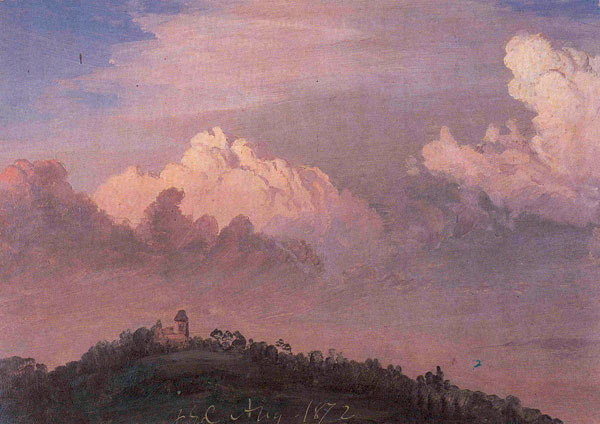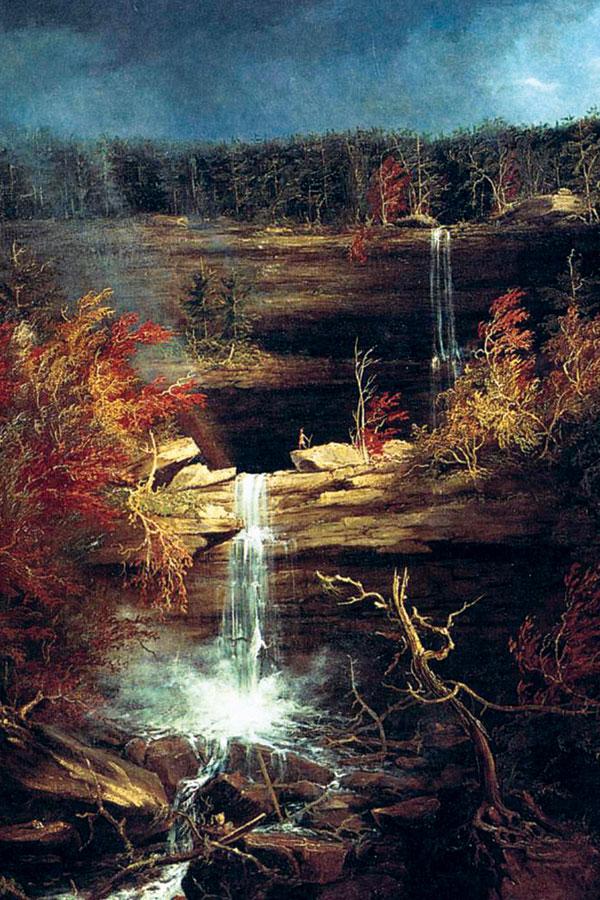Gorgeous Hudson River Valley

What American artists once considered the center of the universe is only about 125 miles up the Hudson River from New York City. As someone who grew up in the West, maybe I can deal with that, but the fact that the center of the universe happens to look something like a Persian harem house from a 1950s pulp romance cover comes as a complete surprise.
Olana, once home of artist Frederic Church, though, does have exactly the view I’d expected: the Hudson River, in low light, turning the water as silver as the good tableware your grandmother only got out at Christmas.
And that’s what I’ve come here for. That view.
Where I come from, you can go hours without seeing a single person and water is rarely more than a trickle. Put me east of the Mississippi River, though, and I not only feel the urge to jump in, find out what that much wet feels like, but the number of people around starts me feeling like I’ve been jammed into the back of a clown car, and it’s never going to completely empty out.
But there was a moment in history when the east was as empty as the landscape in a John Ford cowboy movie, and it was here, along the Hudson, that the record of the time was captured by a group known as the Hudson River school of painters. Depending on which expert you ask, they were active from maybe as early as 1825, certainly by 1850, and had pretty much all died out or gone on to something else by the end of the Civil War. That was when the world’s concerns had moved on to things other than idyllic views of mountains and rivers and crags and dark forests, the landscape of fairy tales and haunts, of places that have never seen a human footprint. Think of them as the visual equivalents of the transcendentalists in writing—Emerson, Thoreau, Muir, who were working at around the same time.
So I’ve come to look at the views they looked at, see if the landscape is still recognizable. See if we can still transcend.
What the Hudson River school did was paint huge canvases of the wild, a world of towering mountains, skies that never stopped, storm clouds the size of whatever countries their ancestors had fled, waterfalls pouring down like nature had nothing whatsoever to do but be profligate. They put Rembrandt light behind endless forests. And if they put people in their work at all, they were tiny, overwhelmed by the scale, by the size of the world itself. Frederic Church, the big gun of the movement, made some paintings so large that when they went on display, audiences used opera glasses so they could see all the details.

The artist painted the estate and its sweeping views multiple times. (Compare this landscape to a painted version, below.)
And that gave him the money to come here, to Olana, where he built a house only slightly smaller than a shopping mall—and now open for tours. His studio is a long room on one end of the house, Persian-influenced details worked into the walls and ceilings, into the shapes of the doorways. Though he travelled widely throughout his career, once Church created Olana, he stayed as close to home as he could. Why bother to go anywhere else? As far as he was concerned, it was truly the center of the world.
And so he spent much of his life painting the river that dominates the view from the front of the house. Olana is home to an American castle, a huge place for huge paintings of a huge landscape. But it’s a weird contrast to Thomas Cole’s own house, just five or 10 minutes away (and to get between the two, you cross the Rip Van Winkle Bridge, which just because of its name makes me ridiculously happy).

Considering the whole school was Cole’s idea to begin with, it’s odd that his whole house isn’t much bigger than Church’s studio. Cole’s house has a balcony on the second floor with no doors leading out to it; even if you climbed out the window, the view would only be of trees. He owned land clear down to the river, but was happy in this house where he couldn’t see the water at all. Did he spend too much time painting, thinking about it? Was he afraid seeing it day after day would ease its power over his imagination, overwhelm him by scale the way it did Church?
Cole’s 1825 Lake with Dead Trees is usually considered the first true Hudson River school painting. It might, in fact, be the first time anybody ever really looked at the United States and didn’t try to see Europe instead. In fact, that’s what the Hudson River school was all about, and what makes Cole and his cohorts so cool, such rebels: They reversed a thousand years of European painting, where, even in a landscape, people were still the most important feature. The Hudson River school is declaring that on a continent the size of North America, humans would never be more than punctuation marks.
The earliest settlers in the United States tried to map the old world onto the new—hence, New England, New York, New Hampshire, New Paltz. The Hudson River school thought a hundred years of this attempt at building a continental mirror was enough; they were the first to try and see the landscape on its own terms, for itself.
One single view dominates the Hudson River school. In the mid-1800s, painters ran through hundreds of gallons of paint, acres of canvas, trying to get a particular bend in the river, the view from West Point, the landscape from the high defensive cliffs that are now the riverside boundary of the military academy. You can still go see the view from there; security just means there are a few hoops to jump through, a lot of ID to show, and then face the whole question of why, on one of the prettiest spots along the entire Hudson River, the military decided to build such … military looking buildings. Even the cathedral looks as though it sucks in sunlight as joyfully as a black hole.
But what the military fails to provide, the world offers in abundance. It’s autumn, and every tree on the grounds is busy showing how lavish nature can be: spend all summer growing leaves, just to toss them, a million shades of red and orange, across the neatly manicured lawn, as exuberant as finger painting done by a kid who just discovered a new box of paints.
I stand on the point, the river wide and slow below me, coming around a bend like a graceful dancer. I roll an acorn I’ve picked up across my fingers, as if I could feel in its smoothness the water below. The far bank is trees and a wildness that I always forget is possible in the eastern United States—sorry, but if you grow up in the west, it’s hard to believe New York is not paved from border to border like a Walmart parking lot.
Maybe it’s inevitable that over the past few years, the Hudson River school has gotten organized by its descendants and fans. Whereas I count on luck and stumbling across what I’m looking for, now assorted organizations are putting together trails, pilgrimages to the homes, the locations, the views. Every town museum along the way, every college, has a few Hudson River school paintings. You could spend a day just in the museum near Sarah Lawrence, moving from one view of the river to another. The Hudson River School Art Trail has put together a guidebook, a brochure of sites, a chance to bring this movement under control.
But wasn’t it really all about a lack of control to begin with? Weren’t the painters trying to show that the landscape was always going to be bigger than the people, that there was no good way to tame it?

I stop at Kaaterskill Falls, outside Palenville, and near where Rip Van Winkle went to sleep. Cole came here by steamboat passing West Point and planning when he’d paint that before reaching the Kaaterskill cliff. When he got there, he painted the falls from both above and below, and the paintings became so famous that a stop here was as important to early tourists on the river as a look at the Statue of Liberty is to a modern New York sightseer. William Cullen Bryant’s poem on the falls, written about the same time Cole was here, says, “’Tis only the torrent tumbling o’er, / In the midst of those glassy walls, / Gushing, and plunging, and beating the floor / Of the rocky basin in which it falls. / ’Tis only the torrent—but why that start? / Why gazes the youth with a throbbing heart?”
I walk to the edge of the falls, the torrent dropping away beneath me—the friend who drove me clearly wishing I was afraid of heights, his heart maybe throbbing a bit more than mine—and look at a century of initials carved into the rocks at the water’s edge. Through the 1800s, the nearby hotels would sell picnic lunches, and you could come here and pretend you were inside a painting all day. Even stay at the hotels, if you could afford the $2.50 a night, and live inside this new idea of landscape, what was really new about the New World. Size. Light. Room to redefine. When my ancestors gave up their farm in Scotland, walking away from stone fences their ancestors had started a thousand years before, here’s what they came for.
And it begins here, with how a bunch of people saw the Hudson. And how they showed us to look at the river and through that river, the world.
Because we were raised by the Hudson to expect beauty to unroll forever outside, if we truly pay attention, we are seldom, if ever, disappointed. On the Hudson, wrote Henry James, we travel through “the strong silver light, all simplifying and ennobling … of the last classic elegance, overhanging vast receding reaches of river, mountain-guarded and dim, which took their place in the geography of the ideal.”
Right now, I have a hundred miles of river left to see. When Nathaniel Hawthorne went up the Hudson on his way to Niagara in 1835, he said he’d been putting it off because he didn’t want “to exchange the pleasures of hope for those of memory.”
The river an evening silver beside me, I roll down the car windows, wondering where I’ll cross that balance point of hope and memory. Or if I’ll just find the balance point among all the other beauties there are to see in the geography of the ideal.
It isn’t until weeks later, when I’m back home, before I realize I never once touched the water. The view was all I needed, the only sense I really had to fill.
Related: Find out where to go and what to see, plus don’t-miss attractions in the Hudson River Valley.
If You Go: Hudson River Valley
In “Gorgeous!” (September/October 2013), Edward Readicker-Henderson toured the Hudson River Valley in search of historic locales related to the Hudson River School of painters. We asked local experts for the skinny on the hottest hotels and B&Bs should you decide to make the same pilgrimage to the homesteads of Frederick Church and Thomas Cole. Click on the interactive map below for location, contact information, and links (click the name of the establishment), or see our listing at the bottom of the page. Make sure to book early, especially in the fall when the autumn colors bring tourism season to its peak.
View Hudson River School: If You Go in a full screen map
What to See:
Olana Historic Site
Home of Hudson River School painter Frederick Church, this 250-acre estate has stunning views of the Hudson River, historic Persian-inspired architecture, and beautiful gardens.
Thomas Cole House – Cedar Grove
Home to Church’s mentor, Thomas Cole, the house offers views of the Castkill Mountains, guided tours of Cole’s home and studio, gardens for strolling, and guided hikes to the spots where Cole would paint his masterpieces.
Hudson River Museum
View a handful of paintings from the Hudson River School of painters on display at this museum of 19th and 20th century American art. If you’re tired of paintings, check out the planetarium or take a walk along the riverfront.
For more to see and do in the Hudson River Valley, click here.
Where to Stay:
The Rhinecliff Hotel (Near Olana)
4 Grinnell Street
Rhinecliff, NY 12574
845-876-0590
This nine-room boutique country hotel is nestled into the bank along the Hudson River. Just two miles from the historic town of Rhinebeck, boutiques, antiquing, and country fairs provide simple, no-frills entertainment for a leisurely day.
Mount Merino Manor (Neighbors Olana)
4317 State Route 23
Hudson, NY 12534
518-828-5583
Built in the 1870s by a friend of Frederic Church, this B&B has seven rooms, many with sweeping views of the Hudson River and the Catskill Mountains. Numerous windows allow for ample natural night, great for viewing the fall foliage.
Mohonk Mountain House
1000 Mountain Rest Road
New Paltz, NY 12561
855-883-3798
Built in 1869, this stunning Victorian castle resort is often named one of the top places to stay by Fodor and Condé Nast magazine. (It also regularly tops the list of best resort spas in the country!) Owned and operated by the Smiley family since its inception, the resort can accommodate up to 600 guests on its sweeping 260 acres.
The Croff House
5 Willard Place
Hudson, NY 12534
518-828-1688
Winner of the 2013 TripAdvisor Certificate of Excellence, this five-guestroom B&B is located on a quiet cul-de-sac street in historic Hudson, New York. Boutique hotel-style amenities like high quality bed and bath linens and a freshly prepared, gourmet breakfast, meet classic B&B attention to experience with nightly turndown service and quaint porches and gardens for respite.
The Garrison
Route 9
Garrison, NY 10524
845-424-3604
On a mountain overlooking West Point and the Hudson, this four-room inn sits on 300 acres and boasts 360 degree views of the Hudson River and surrounding mountainous landscape. The Garrison is Readicker-Henderson’s choice for best river views, and it’s just around Storm King Mountain and Anthony’s Nose–a favorite spot of the Hudson River painters. Did we mention the 18-hole golf course and critically-acclaimed restaurant (Valley) lauded by the likes of Bon Appetit, Town & Country, Esquire, and The New York Times?
The Roundhouse at Beacon Falls
2 East Main Street
Beacon, NY 12508
845-765-8369
For contemporary elegance, don’t miss this 14-room boutique hotel in Beacon, NY, a town Readicker-Henderson calls the hottest art center in the country (the renowned Dia Museum of Modern Art is there). Ideally located near shops, galleries, and restaurants, the hotel also has two penthouse suites with views of Fishkill Creek and Beacon Falls from the attached private roof decks.